
I haven’t posted over here for ages. It’s a drizzly day here on the coast of Maine, so it seems like the perfect time to get caught up. You might know that I have two blogs now. This one, where I’ve always wanted to show and share my process; and the newer blog over at Holdfastbespoke.com, where I try to be more “professional”. Sadly, this one has suffered, as I’ve worked on getting a little home-based tailoring service off the ground.
I have to say that it’s nice to be “over here”, back in my old stomping grounds where I don’t have to worry about using the right key words to increase my SEO visibility. Should anyone at my age even know what SEO is? Sometimes I wonder. Anyway, today’s a day to break free of all that insanity and talk about my most recent make; a Donegal tweed overcoat.

I should provide a little background on how this all transpired.
Meeting with a business adviser through the Small Business Administration has been one of the best decisions I ever made. Needless to say, they don’t get many people coming in to start a bespoke tailoring business. I was encouraged to go out, start networking and do some market research. All the things that an introvert hates! Knowing you only get one chance to make a first impression, I put on my winter white overcoat, (it was February), and walked into David Wood Clothiers in Portland, Maine.
Talk about kismet!
Passionate maker meets passionate retailer. We discussed the need for men’s outerwear, outside the sea of barn jackets and puffer coats that are everywhere. Before I knew it I’d agreed to make a prototype easy fitting overcoat for them. It was the big break I needed, and a huge opportunity to put my tailoring education to work.
Enter Winifred Aldrich.

One of my classmates at The Tailoring Academy had used the women’s version of this book for an independent study project. We talked several times over the phone as I worked my way through it; mostly about how much paper and tape it takes! I won’t lie, I struggled with the raglan sleeve conversion. My first attempt ended up in the wastebasket. But as sewists, we carry on. I eventually worked it out, and I’m glad I stuck it out. I was working with standardized measurements for a size 40S, and the fit was spot on. Amazing. Now I’m a confirmed Winifred Aldrich believer. I would encourage anyone interested in drafting their own patterns to give Winifred a try. Getting a bigger wastebasket is optional.






All the paper, tape and cursing resulted in this coat, which I documented over on the Hold Fast Bespoke website. Those posts are sort of “sanitized for SEO” in mind; all in an attempt to have Google notice me. I can report that it hasn’t helped a bit! I’m still way down in the search, after all the dry cleaners. It’s all OK. At the end of the day, I’d much rather be working in my workroom than fretting about my visibility to the Google bots.

The prototype coat was a hit with David Wood and with me. (I wore it almost daily this spring). It was time to kick it up a notch. Something that their discerning customers would appreciate and hopefully buy. We flipped through the Holland & Sherry “Sherry Tweed” bunch book and selected this Donegal. The orange and blue flecks proved irresistible. I believe they’re properly called “neps”. Because David Wood Clothiers has a 35 year history with Holland & Sherry, they were able to order the fabric for me at a great price. Even so this kind of fabric doesn’t come cheap. Trust me, I was extra cautious, checking everything twice before letting the shears touch it.

For safety’s sake I made a muslin “crop top” just to be extra sure my draft was correct. It was also a trial run for the back storm shield. It went together flawlessly. Thank you Winifred Aldrich! My time at The Tailoring Academy turned me into a metric sewist. If you decide to get her book, you’ll become one too. It’s so much simpler, and I’m not panicked by 3/8″ (1 Cm) seam allowances anymore!


I referred frequently to my school notes when it came time to chalk out the coat. One of the characteristics of bespoke garments is the extra fabric (inlays) added to specific seams. They allow the garment to be altered to a changing shape. In this coat there is almost four inches of extra fabric at the waist; slightly less at the chest and the sleeve biceps. Taking into consideration the various inlays, the pattern is chalked on with the goal of minimizing waste. It can be a puzzle. One that I enjoy.

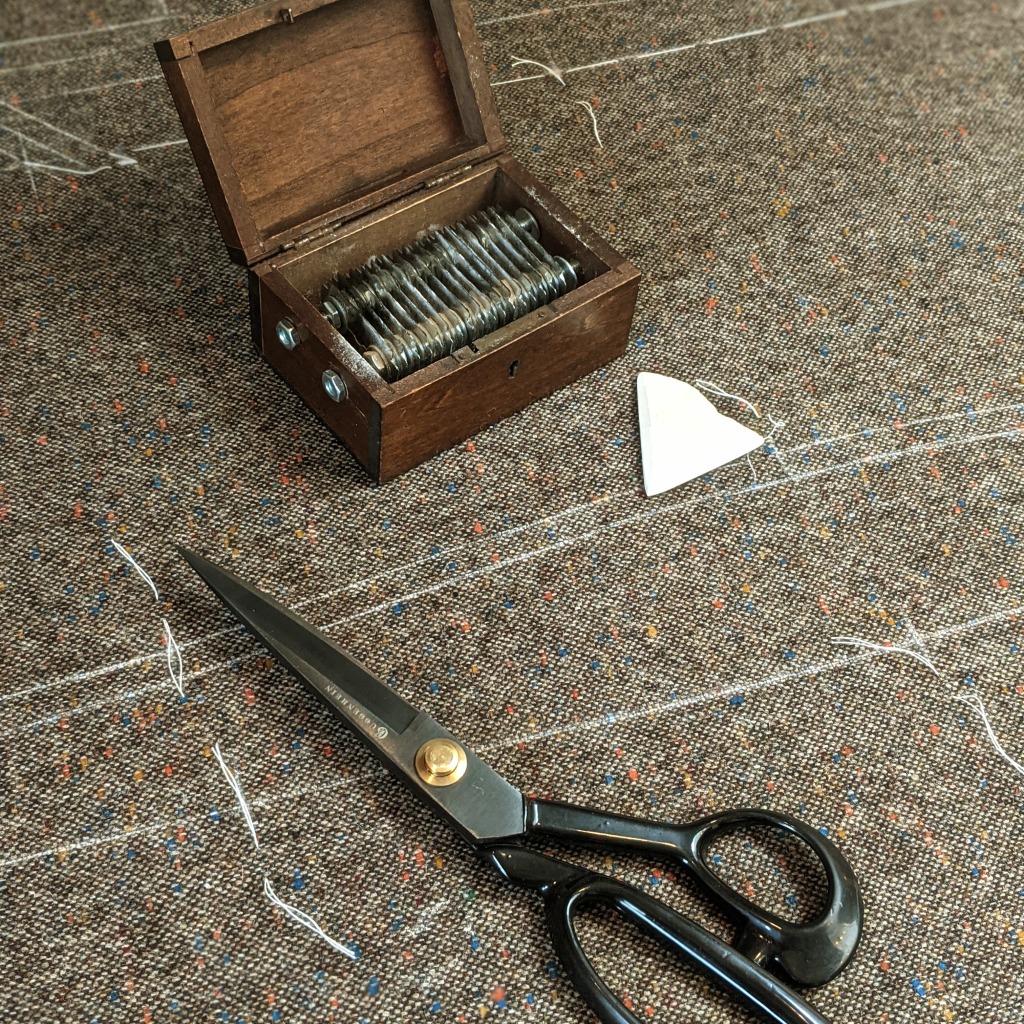
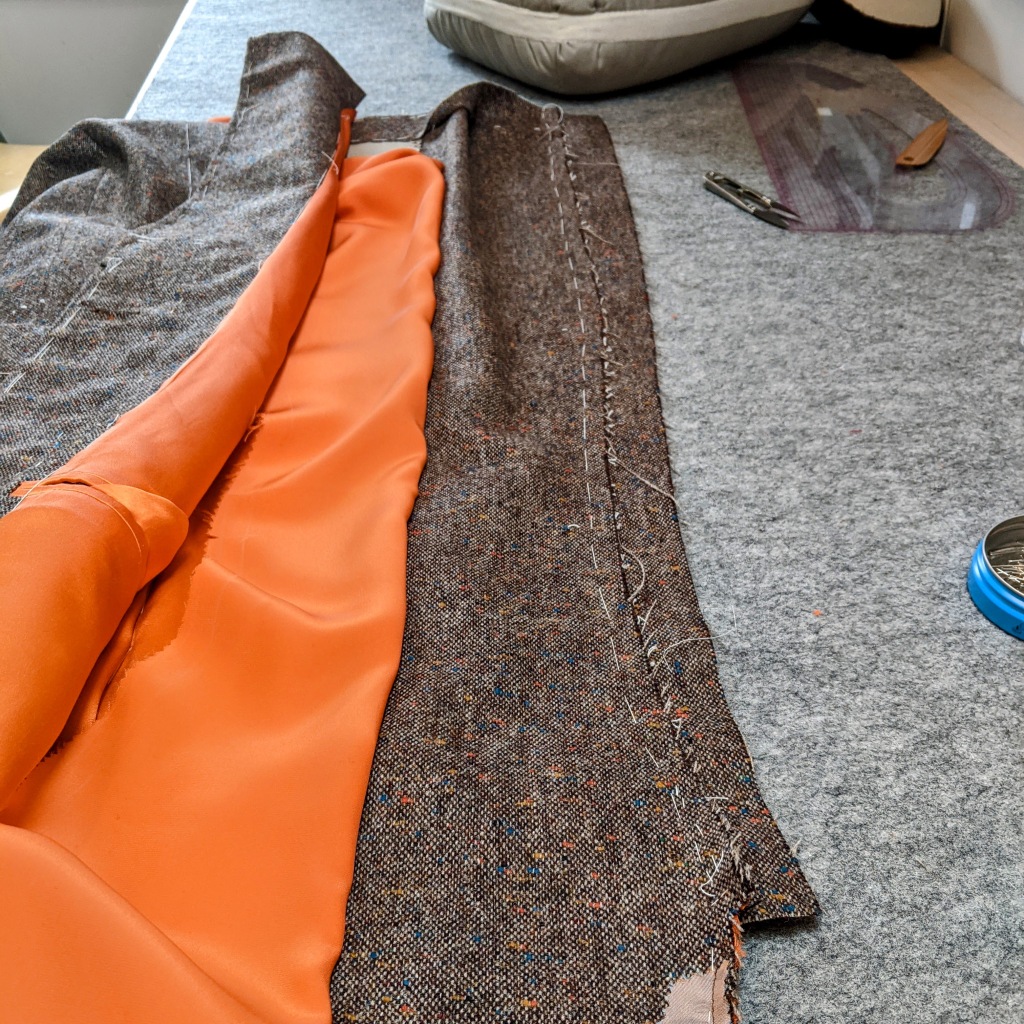
I adapted many of the techniques used in a traditional fully canvased jacket. There’s a hair canvas front starting at the mid shoulder point, extending to a “tab” that reinforces the pocket opening. From the mid point of the pocket the canvas runs to the hem. The canvas is replaced with a bias cut rayon tape at the seams to reduce bulk. Strips of lining material are sewn into the bias seams of the raglan sleeve to prevent stretching. Knowing the “why” of all the various materials can boost one’s confidence when tailoring / sewing “off script”. It’s all problem solving, and that’s what all sewists do regardless of the project.


The Donegal tweed fabric really demanded an orange lining. I went with this burnt orange silk charmeuse from Mood. Luxurious but demanding. It took a full two and half hours to cut out. At only 45″ wide, the layout was tricky; especially since the lining must have inlays to match the wool. It’s heaven to touch, but I’m ambivalent about its use. A cupro lining would have been just as nice, and maybe more practical. I just couldn’t find any in this color. I hope that changes with time. Finding suppliers has been one of my biggest challenges, but it’s getting better.
Here are just a few shots of the coat in process. I love making outerwear, but it can turn into a beast sometimes. I have to make my small workspace work.
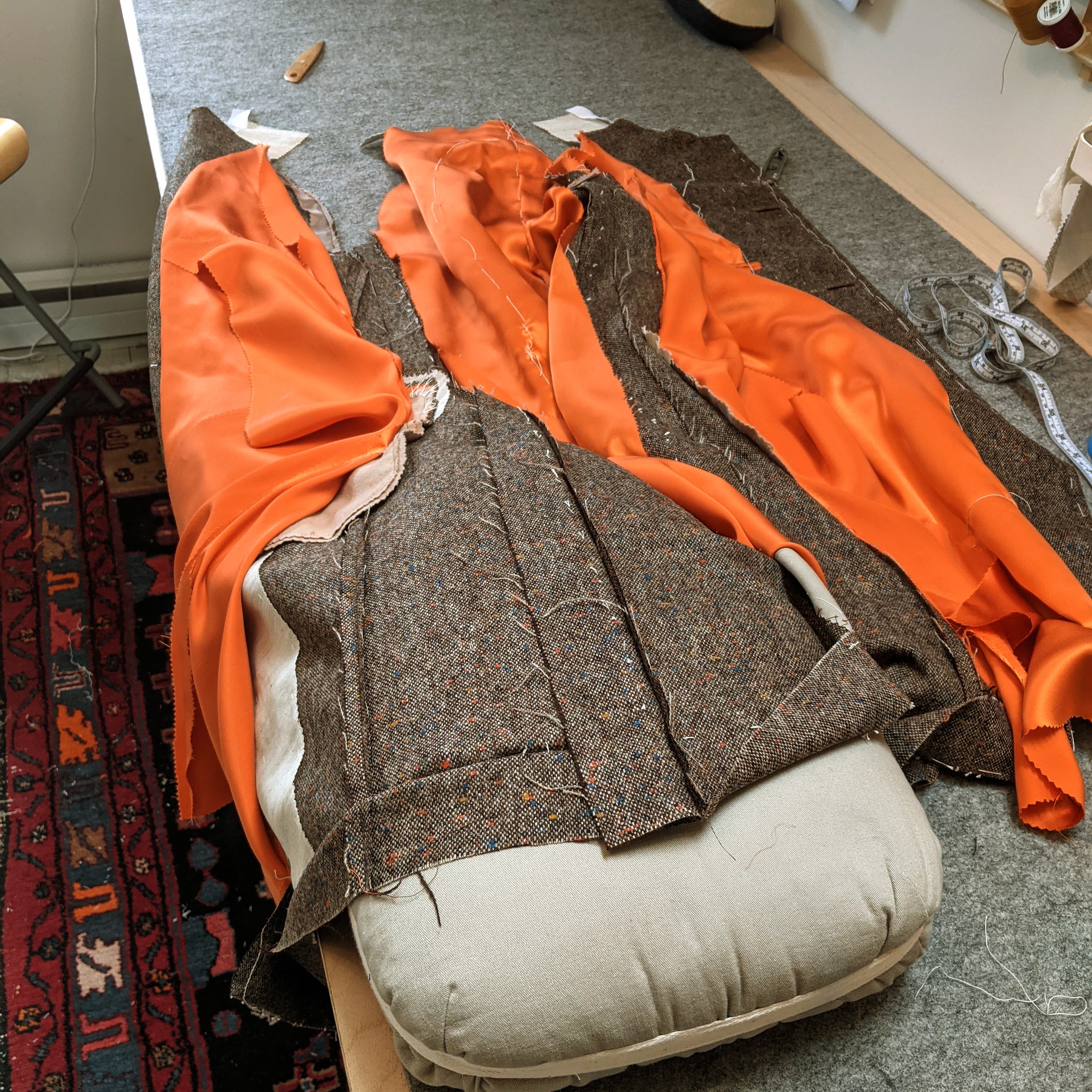

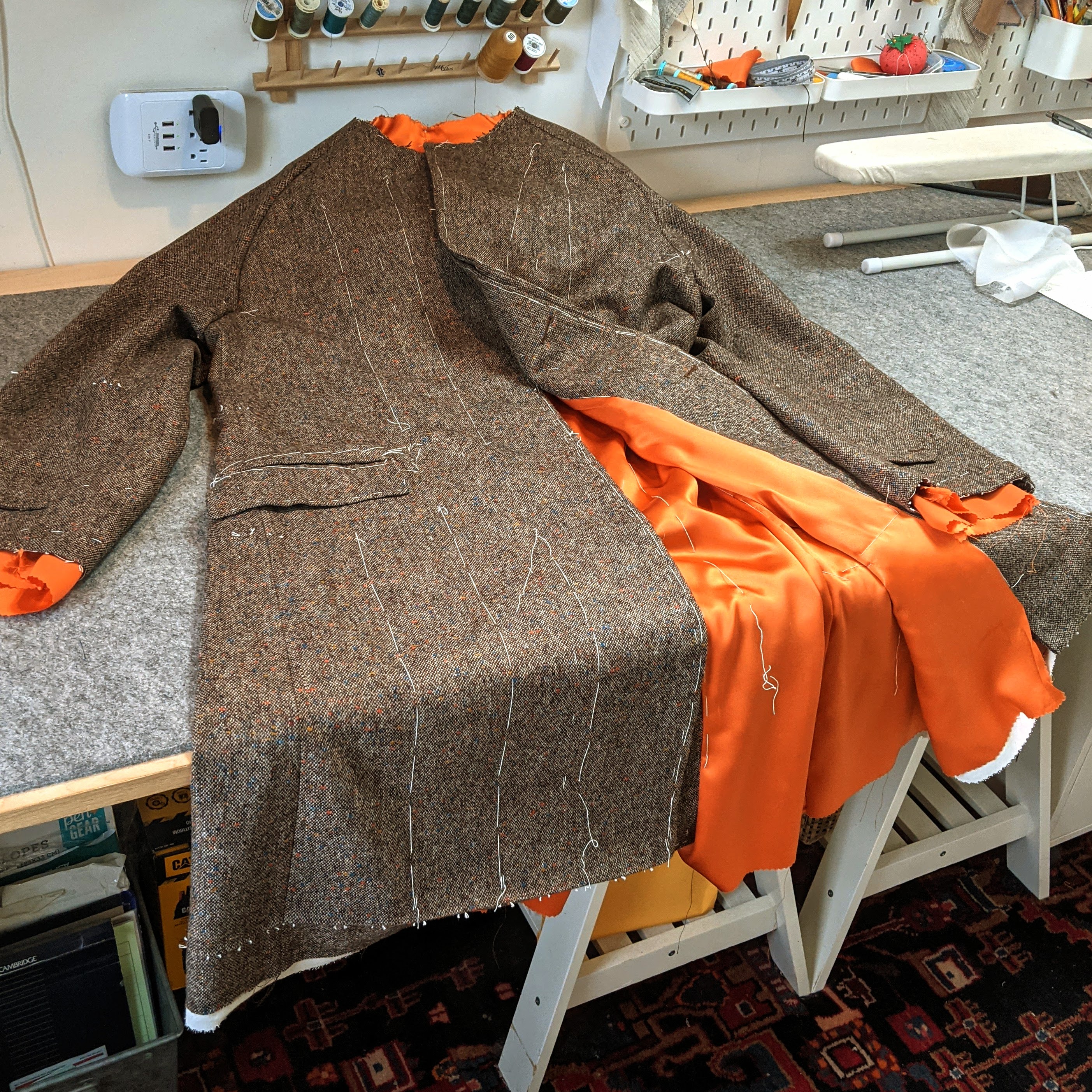
There’s an extensive amount of hand pick stitching on this coat that goes unseen. I played it safe by keeping it the same brown as the tweed. The pick stitching is not only decorative, it actually serves a purpose. It actually preserves the shape of the coat’s edges; especially along the front opening, the back vent and the collar. I purchased a magnifying headset from Wawak which made the job so much easier. What took me so long! All the buttonholes are handworked with silk buttonhole twist.


I showed the finished coat at David Wood Clothiers on June 1st at their Makers Day. It generated a bit of a stir with their loyal clientele. I have no idea where it might lead, but I’m up for the adventure. Here are a few shots of the finished coat.





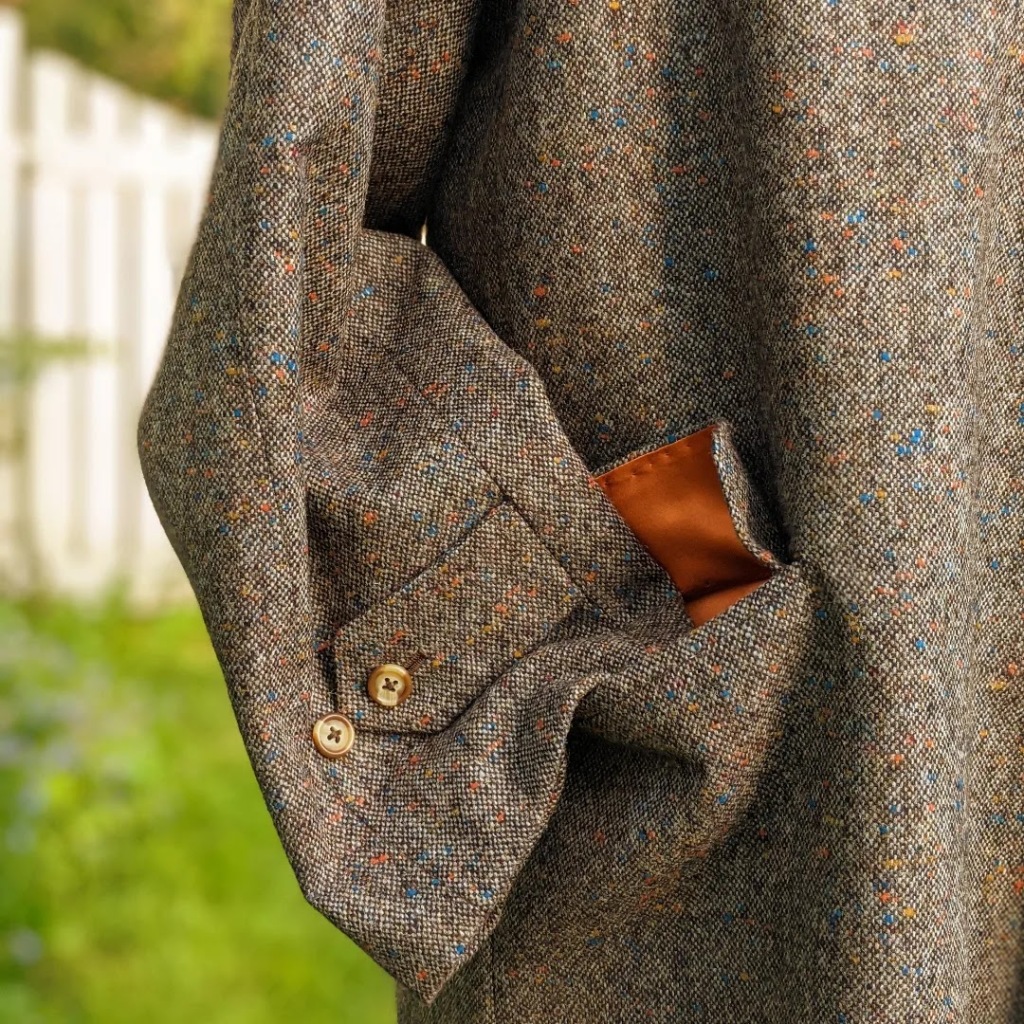
Now that this project is finished I’m turning my attention to “Agnes”. She hasn’t been in the water for two years and needs a bit of sprucing up before she hits the water. Her Winter renters were certainly cozy, but not very neat. They’re definitely not getting their deposit back!

Happy tailoring / sewing to all!
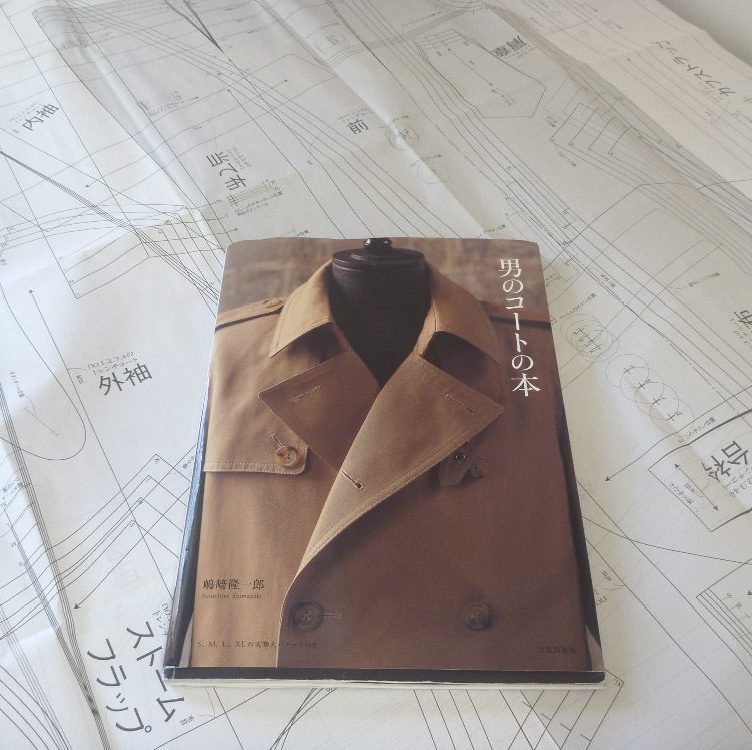
Such impressive work, down to the buttonholes. Best wishes for Holdfast Bespoke and thanks for the in-progress details.
LikeLiked by 1 person
Well done you! Wonderful neps colorings in this wool – what a luxurious treat it must have been to work with!
LikeLiked by 2 people
This was so fascinating to read. You are so gifted. Enjoy your time with Agnes. Hope our weather is cooperative! See you soon. Been capturing those nasty ticks🥰
LikeLiked by 1 person
What an exciting read! Congratulations on your progression!
LikeLiked by 1 person
Gorgeous coat. Glad to see your post.
LikeLiked by 1 person
Thanks for taking the time to create this post. Your work is an inspiration.
LikeLiked by 1 person
Hi Duane, I’m happy to see this blog and your progress! That’s a beautiful coat! And thanks for the hints on book and everything else. Might I suggest Core Fabrics for many cupro colors? In my experience, they ship from the US. And a question – where do you get silk buttonhole thread? I’m almost to just that remaining step in my linen cotton Bemberg lined jacket.😊 Thanks.
LikeLiked by 1 person
I used the Core fabrics cupro on the prototype. I would have used it again but it wasn’t available in orange. At least that’s what I remember. You will find silk buttonhole thread at Red Rock Threads. They have a pretty good selection. It comes in 30 m spools, so you can do a couple of practice buttonholes before you dive in. At least that’s what I do.
LikeLike
How amazing this journey and what a beautiful coat. The orange lining is perfect. Hope you attract some coat lovers. Not too many, that would ruin the joy in making them.
LikeLiked by 1 person
Hi Duane, Brilliant work as we have come to expect, the English course has just added the final piece in the jigsaw for you and I wish you well with your bespoke journey. Thanks for the updates and look forward to many more in the future.
LikeLiked by 1 person
Beautiful coat. Hope it’s sold already.
LikeLike
Thank you for sharing your story with us. It is not something that I will ever do but I
enjoy seeing what you are doing. Happy summer to you.
Terry
LikeLike
So good to ‘hear’ from you!
LikeLiked by 1 person
This coat is perfect in every way. A raglan style needs that spot on fit and custom tailoring and this style will last forever for a life time. Oh, and Mr B commented that the buttonhole was the finest he has seen and he is constantly complaining about bad ones. Now I must google SEO to find out and what it is.
LikeLiked by 1 person
I keep banging away at my buttonholes. Slowly but surely they’re getting better. I should practice more, but I know I won’t! The magnifying headset was a game changer.
LikeLike
Thank you for sharing the making details of this glorious coat. I love reading about your process with each garment. The tip about using strips of lining to support the raglan sleeve seam was a new one to me. It will come in handy for when I get finally around to making the winter coat on my to sew list.
LikeLike
Very nice coat and you always do such great tailoring work. It is unfortunate you can’t see that work from the finished product. I had the winifred book (lost in an estate statement due and an evil greedy brother) I am going to find my sewing mojo again and would like to do some more bespoke tailoring,
I know that you took the course but I don’t have time do that kind of thing for various reasons but would like to know what resources I should consult to help me on own self study journey. I am going to start with a few vintage vogue patterns and I find my options these days very open since I went from 235lbs down to 160lbs (still dropping) thank-you covid.
I greatly appreciate your advice Duane and I will also reach out to you on instagram since I follow you. Best regards Corey Hill
LikeLike